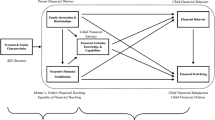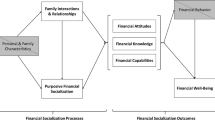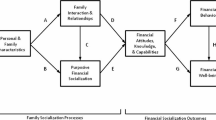Abstract
The current study examined the role of attachment insecurity, locus of control, and parental financial communication on the financial behavior of emerging adults from a family financial socialization theory perspective. Data were used from the Emerging Adult Financial Capability Study, the sample consisted of emerging adult college students (N = 321) from a large southeastern university in the United States. Structural equation modeling was used to examine the direct and indirect effects as well as the overall fit of the model that was constructed according to family financial socialization theory. Results suggested that increased attachment insecurity predicted decreased financial communication from parents and a decreased perception of an internal locus of control. Emerging adults who received greater financial instruction (both direct and indirect) and who felt they had a greater ability to influence outcomes in their life engaged in more sound financial behavior. Results also suggested that financial communication and locus of control mediated the relationship between attachment insecurity and financial behavior. The findings supported the inclusion of attachment as an important family relationship variable in the financial socialization process, as well as the structure of a conceptual model of family financial socialization theory.


Similar content being viewed by others
References
Arnett, J. J. (1994). Are college students adults? Their conceptions of the transition to adulthood. Journal of Adult Development, 1, 154–168. doi:10.1007/BF02277582.
Arnett, J. J. (1997). Young people’s conceptions of the transition to adulthood. Youth & Society, 29, 1–23. doi:10.1177/0044118X97029001001.
Arnett, J. J. (1998). Learning to stand alone: The contemporary American transition to adulthood in cultural and historical context. Human Development, 41, 295–315. doi:10.1159/000022591.
Arnett, J. (2001). Conceptions of the transition to adulthood: Perspectives from adolescence through midlife. Journal of Adult Development, 8(2), 133–143.
Atkinson, A., McKay, S., Kempson, E., & Collard, S. (2006). Levels of financial capability in the UK: Results of a baseline survey (Consumer Research No. 47). Retrieved from Financial Services Authority website: http://www.fsa.gov.uk/pubs/consumer-research/crpr47.pdf.
Bandura, A. (1977). Self-efficacy: Toward a unifying theory of behavioral change. Psychological Review, 84(2), 191–215. doi:10.1037/0033-295X.84.2.191.
Bandura, A. (1997). Self-efficacy: The exercise of control. New York: Freeman.
Baron, R. M., & Kenny, D. A. (1986). The moderator–mediator variable distinction in social psychological research: Conceptual, strategic, and statistical considerations. Journal of Personality and Social Psychology, 51(6), 1173–1182. doi:10.1037/0022-3514.51.6.1173.
Bowlby, J. (1973). Separation. New York: Basic Books.
Bowlby, J. (1980). Attachment and loss: Vol. 3. Loss, sadness, and depression. New York: Basic Books.
Bowlby, J. (1982). Attachment and loss: Vol. 1. Attachment (2nd ed.). New York: Basic Books (originally published in 1969).
Brennan, K. A., Clark, C. L., & Shaver, P. R. (1998). Self-report measurement of adult attachment: An integrative overview. In J. A. Simpson (Ed.), Attachment theory and close relationships (pp. 46–76). New York, NY: Guilford Press.
Britt, S., Cumbie, J. A., & Bell, M. M. (2013). The influence of locus of control on student financial behavior. College Student Journal, 41, 178–184.
Busseri, M. A., Lefcourt, H. M., & Kerton, R. R. (1998). Locus of control for consumer outcomes: Predicting consumer behavior. Journal of Applied Social Psychology, 28(12), 1067–1087. doi:10.1111/j.1559-1816.1998.tb01668.x.
Carlson, L., & Grossbart, S. (1988). Parental style and consumer socialization of children. Journal of Consumer Research, 15(1), 77–94. doi:10.1086/209147.
Chen, F., Bollen, K. A., Paxton, P., Curran, P. J., & Kirby, J. B. (2001). Improper solutions in structural equation models: Causes, consequences, and strategies. Sociological Methods & Research, 29(4), 468–508. doi:10.1177/0049124101029004003.
Clarke, M. C., Heaton, M. B., Israelsen, C. L., & Eggett, D. L. (2005). The acquisition of family financial roles and responsibilities. Family and Consumer Sciences Research Journal, 33(4), 321–340. doi:10.1177/1077727X04274117.
Cohen, P., Kasen, S., Chen, H., Hartmark, C., & Gordon, K. (2003). Variations in patterns of developmental transitions in the emerging adulthood period. Developmental Psychology, 39, 657–669. doi:10.1037/0012-1649.39.4.657.
Collins, W., Maccoby, E. E., Steinberg, L., Hetherington, E., & Bornstein, M. H. (2000). Contemporary research on parenting: The case for nature and nurture. American Psychologist, 55(2), 218–232. doi:10.1037/0003-066X.55.2.218.
Danes, S. M. (1994). Parental perceptions of children’s financial socialization. Financial Counseling and Planning, 5, 127–149.
Danes, S. M., & Dunrud, T. (1993). Children and money: Teaching children money habits for life. Minnesota Extention Service Publication, HE-FO-6116, University of Minnesota.
Danes, S. M., & Haberman, H. R. (2007). Teen financial knowledge, self-efficacy, and behavior: A gendered view. Journal of Financial Counseling & Planning, 18(2), 48–60.
Davies, E., & Lea, S. E. G. (1995). Student attitudes to debt. Journal of Economic Psychology, 16, 663–679.
Dillon, W. R., Kumar, A., & Mulani, N. (1987). Offending estimates in covariance structure analysis: Comments on the causes of and solutions to Heywood cases. Psychological Bulletin, 101(1), 126–135. doi:10.1037/0033-2909.101.1.126.
Elliot, W., Constance-Huggins, M., & Song, H. (2013). Improving college progress among low- to moderate-income (LMI) young adults: The role of assets. Journal of Family and Economic Issues, 34, 382–399.
Emerson, E., Donenberg, G. R., & Wilson, H. W. (2012). Health-protective effects of attachment among African American girls in psychiatric care. Journal of Family Psychology, 26(1), 124–132. doi:10.1037/a0026352.
Flouri, E. (2004). Exploring the relationship between mothers’ and fathers’ parenting practices and children’s materialist values. Journal of Economic Psychology, 25(6), 743–752. doi:10.1016/j.joep.2003.06.005.
Fraley, R., Waller, N. G., & Brennan, K. A. (2000). An item response theory analysis of self-report measures of adult attachment. Journal of Personality and Social Psychology, 78(2), 350–365. doi:10.1037/0022-3514.78.2.350.
Furnham, A. (1986). Economic locus of control. Human Relations, 39, 29–43. doi:10.1177/001872678603900102.
Greene, A. L., Wheatley, S. M., & Aldava, J. F, I. V. (1992). Stages on life’s way: Adolescents’ implicit theories of the life course. Journal of Adolescent Research, 7, 364–381. doi:10.1177/074355489273006.
Gudmunson, C. G., & Danes, S. M. (2011). Family financial socialization: Theory and critical review. Journal of Family and Economic Issues, 32(4), 644–667. doi:10.1007/s10834-011-9275-y.
Hancock, A. M., Jorgensen, B. L., & Swanson, M. S. (2013). College students and credit card use: The role of parents, work experience, financial knowledge, and credit card attitudes. Journal of Family and Economic Issues, 34(4), 369–381. doi:10.1007/s10834-012-9338-8.
Hathaway, I. & Khatiwada, S. (April 2008). Do Financial Education Progarms Work? Retrieved from http://poseidon01.ssrn.com/delivery.php?ID=406105097031082071026087090074100030017003038044067033122101111102092028124086022007007019055119006003021110114001083116096006030087011040086072117099115121087097053006020119074113125119031123070093120117068112005098089094000005101108068117105084083&EXT=pdf.
Hopwood, A. G. (2007). Whither accounting research? The Accounting Review, 82(5), 1365–1374.
Hu, L., & Bentler, P. M. (1999). Cutoff criteria for fit indexes in covariance structure analysis: Conventional criteria versus new alternatives. Structural Equation Modeling, 6(1), 1–55. doi:10.1080/10705519909540118.
Institute for Personal Financial Planning. (2007). Financial therapy clinic. Retrieved from http://www.ipfp.k-state.edu/clinic/.
Johnson, E., & Sherraden, M. S. (2007). From financial literacy to financial capability among youth. Journal of Sociology & Social Welfare, 34(3), 119–146.
Joo, S. H., Grable, J. E., & Bagwell, D. C. (2003). Credit card attitudes and behaviors of college students. College Student Journal, 37(3), 405–419.
Jorgensen, B. L., Rappleyea, D., & Taylor, A. (2014). Understanding financial literacy and competence: Considerations for training, collaboration and referral for MFTs. Journal of Financial Therapy, 5, article 2. doi: 10.4148/1944-9771.1062.
Jorgensen, B. L., & Savla, J. (2010). Financial literacy of young adults: The importance of parental socialization. Family Relations, 59(4), 465–478. doi:10.1111/j.1741-3729.2010.00616.x.
Lefcourt, H. M. (1966). Internal versus external control of reinforcement: A review. Psychological Bulletin, 65(4), 206–220. doi:10.1037/h0023116.
Lefcourt, H. M. (1972). Recent developments in the study of locus of control. In B. A. Maher (Ed.), Progress in experimental personality research (Vol. 6, pp. 1–39). New York: Academic Press.
Lefcourt, H. M. (1982). Locus of control: Current trends in theory and research (2nd ed.). Hillsdale, NJ: Lawrence Erlbaum.
Levenson, H. (1973). Multidimensional locus of control in psychiatric patients. Journal of Consulting and Clinical Psychology, 41(3), 397–404. doi:10.1037/h0035357.
MacCallum, R. C., Browne, M. W., & Sugawara, H. M. (1996). Power analysis and determination of sample size for covariance structure modeling. Psychological Methods, 1(2), 130–149. doi:10.1037/1082-989X.1.2.130.
Maccoby, E. E. (1992). The role of parents in the socialization of children: An historical overview. Developmental Psychology, 28(6), 1006–1017. doi:10.1037/0012-1649.28.6.1006.
Magoon, M. E., & Ingersoll, G. M. (2006). Parental modeling, attachment, and supervision as moderators of adolescent gambling. Journal of Gambling Studies, 22(1), 1–22. doi:10.1007/s10899-005-9000-6.
Mandell, L. (2008). The financial literacy of young American adults: Results of the 2008 national JumpStart coalition survey of high school seniors and college students. Retrieved from JumpStart Coalition for Personal Financial Literacy website: http://www.jumpstartcoalition.org/upload/2009BookcompleteafterLewEdits.pdf.
McNally, A. M., Palfai, T. P., Levine, R. V., & Moore, B. M. (2003). Attachment dimensions and drinking-related problems among young adults the meditational role of coping motives. Addictive Behaviors, 28(6), 1115–1127. doi:10.1016/S0306-4603(02)00224-1.
McNeal, J. V. (1987). Children as consumers: Insights and implications. Lexington, MA: Lexington Books.
Mickelson, K. D., Kessler, R. C., & Shaver, P. R. (1997). Adult attachment in a nationally representative sample. Journal of Personal Social Psychology, 73(5), 1092–1106.
Moschis, G. P. (1987). Consumer socialization: A life cycle perspective. Lexington, MA: Lexington Books.
Mugenda, O. M., Hira, T. K., & Fanslow, A. M. (1990). Assessing the causal relationship among communication, money management practices, satisfaction with financial status, and satisfaction with quality of life. Lifestyles, 11(4), 343–360. doi:10.1007/BF00987345.
Peng, T. M., Bartholomae, S., Fox, J. J., & Cravener, G. (2007). The impact of personal finance education delivered in high school and college courses. Journal of Family and Economic Issues, 26(2), 265–284. doi:10.1007/s10834-007-9058-7.
Petrogiannis, K. (2011). Conceptions of the transition to adulthood in a sample of Greek higher education students. International Journal of Psychology & Psychological Therapy, 11(1), 121–137.
Plunkett, H. R., & Buehner, M. J. (2007). The relational and specific locus of control to intertemporal monetary choice. Personality and Individual Differences, 42(7), 1233–1242.
PNC Bank. (2011). PNC financial independence survey: A national study of the financial mindset of 20-somethings. Retrieved from: https://www.pnc.com/.
Porter, N. M., & Garman, E. T. (1993). Testing a conceptual model of financial well-being. Financial Counseling and Planning, 4, 135–164.
Qualtrics Research Suite (Version 32,777) [Computer software]. Provo, UT: Qualtrics.
Rappleyea, D., Jorgensen, B. L., Taylor, A., & Butler, J. L, V. I. (2014). Training considerations for MFTs in couple and financial counseling. American Journal of Family Therapy, 14, 282–292. doi:10.1080/01926187.2013.847701.
Reid, D., & Ware, E. E. (1974). Multidimensionality of internal versus external control: Addition of a third dimension and non-distinction of self versus others. Canadian Journal of Behavioural Science, 6(2), 131–142. doi:10.1037/h0081862.
Rettig, K. D. (1985). Consumer socialization in the family. The Journal of Consumer Education, 3, 1–7.
Rettig, K. D., & Mortenson, M. (1986). Household production of financial management competencies. In R. Deacon & W. Huffman (Eds.), Human Resources Research 1887–1987 (pp. 137–145). Ames, IA: Iowa State University.
Roland-Lévy, C. (2002). Economic socialization: How does one develop an understanding of the economic world? In M. Huchings, M. Fülöp & A. M. Van den dries (Eds), Young people’s understanding of economic issues in Europe, European issues in children’s identity and citizenship (pp. 17–30). Stoke-on-Trent: Trenham Books.
Rotter, J. B. (1975). Some problems and misconceptions related to the construct of internal versus external control of reinforcement. Journal of Consulting and Clinical Psychology, 43(1), 56–67. doi:10.1037/h0076301.
Sakalaki, M., Richardson, C., & Bastounis, M. (2005). Association of economic internality with saving behavior and motives, financial confidence, and attitudes toward state intervention. Journal of Applied Social Psychology, 35(2), 430–443.
Scheer, S. D., Unger, D. G., & Brown, M. B. (1996). Adolescents becoming adults: Attributes for adulthood. Adolescence, 31(121), 127–131.
Schreiber, J. B., Stage, F. K., King, J., Nora, A., & Barlow, E. A. (2006). Reporting structural equation modeling and confirmatory factor analysis results: A review. The Journal of Educational Research, 99(6), 323–337. doi:10.3200/JOER.99.6.323-338.
Shaver, P. R., & Mikulincer, M. (2007). Adult attachment strategies and the regulation of emotion. In J. J. Gross (Ed.), Handbook of emotion regulation (pp. 446–465). New York, NY: Guilford Press.
Sherraden, M. S. (2010). Financial capability: What is it, and how can it be created? (CSD Working Paper No. 10–17). Retrieved from Center for Social Development website: http://csd.wustl.edu/Publications/Documents/WP10-17.pdf.
Sirsch, U., Dreher, E., Mayr, E., & Willinger, U. (2009). What does it take to be an adult in Austria: Views of adulthood in Austrian adolescents, emerging adults, and adults. Journal of Adolescent Research, 24(3), 275–292. doi:10.1177/0743558408331184.
Sroufe, L. A. (1979). The coherence of individual development: Early care, attachment, and subsequent developmental issues. American Psychologist, 34(10), 834–841. doi:10.1037/0003-066X.34.10.834.
Sroufe, L., & Waters, E. (1977). Attachment as an organizational construct. Child Development, 48(4), 1184–1199. doi:10.2307/1128475.
SPSS AMOS (Version 20.0.0) [Computer software]. Armonk, New York: IBM.
Tokunaga, H. (1993). The use and abuse of consumer credit: Application of psychological theory and research. Journal of Economic Psychology, 14(2), 285–316.
Totenhagen, C. J., Casper, D. M., Faber, K. M., Bosch, L. A., Wiggs, C. B., & Borden, L. M. (2015). Youth financial literacy: A review of key considerations and promising delivery methods. Journal of Family and Economic Issues, 36, 167–191. doi:10.1007/s10834-014-9397-0.
Ward, S. (1974). Consumer socialization. Journal of Consumer Research, 1(2), 1–14. doi:10.1086/208584.
Yates, D., & Ward, C. (2011). Financial literacy: Examining the knowledge transfer of personal finance from high school to college to adulthood. American Journal of Business Education, 4(1), 65–78.
Yu, C. Y. (2002). Evaluation of model fit indices for latent variable models with categorical and continuous outcomes. Unpublished dissertation. Retrieved February 5, 2013, from Mplus website http://www.statmodel.com/download/Yudissertation.pdf.
Author information
Authors and Affiliations
Corresponding author
Rights and permissions
About this article
Cite this article
Jorgensen, B.L., Rappleyea, D.L., Schweichler, J.T. et al. The Financial Behavior of Emerging Adults: A Family Financial Socialization Approach. J Fam Econ Iss 38, 57–69 (2017). https://doi.org/10.1007/s10834-015-9481-0
Published:
Issue Date:
DOI: https://doi.org/10.1007/s10834-015-9481-0




